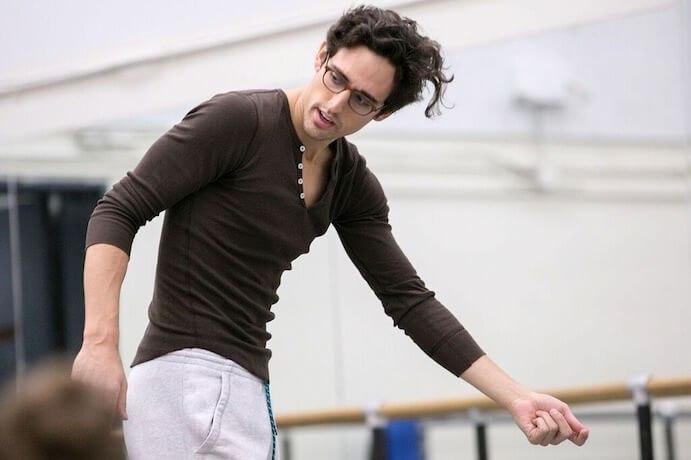On Thursday, February 11, 2016 at the David H. Koch Theater, the New York City Ballet and its orchestra presented “New Combinations,” a program filled to the brim with works by contemporary choreographers. In the case of ballets by Resident Choreographer Justin Peck and Corps de Ballet member Troy Schumacher, there was new music to accompany the action onstage.
The program opened with Polaris, in which the youthful vitality and elegance of Myles Thatcher’s choreography worked well with the folksy charm of the “Allegramente” from William Walton’s Piano Quartet in d minor. The fluidity and persistence of motion projected languid strength in movements that admirably defied gender conventions with same-sex pairings. The Blue Distance took on a decidedly more impressionistic tone, from the excerpts of Maurice Ravel’s iridescent piano suite Miroirs to the delicate, deliberate choreography by Robert Binet. The strength and poise of the dancers came to to the fore as they temporarily halted their movements, as if frozen in time, before suddenly bursting into pas de deux fragments, which corresponded perfectly with the cascading piano lines.
Common Ground featured a score from Ellis Ludwig-Leone (of the indie pop band San Fermin) that was brash in its beauty. The small ensemble of dancers was dressed in multicolored costumes that would be ideal for a tUnE-yArDs music video. Schumacher’s choreography, though pretty, suffered from a certain monotony that comes from blind repetition. As the ballet went on, assertive post-minimalist flourishes in the woodwinds were countered by syncopation in the strings and piano. The repetition in the choreography then took on cohesion and fresh exuberance, as if responding to the increased intensity of the music. The evening moved to the narrative form with choreographer Christopher Wheeldon’s Estancia (music by Alberto Ginastera), a ballet about a city slicker who moves to the countryside and becomes a cowboy, all to win the heart of a woman. The performance was most notable for the smoldering chemistry between Tyler Angle as City Boy and and Tiler Peck as Country Girl. With clear, demonstrative choreography, at various times Wheeldon enabled the dancers to articulate both the rugged, rustic feel of the country and the bustle of the big city.

Choreographer Justin Peck– Photo by Erin Baiano
But the best was saved for last with The Most Incredible Thing by Peck and composer Bryce Dessner of The National, in its world premiere run. Peck’s first narrative ballet, the story is a retelling of a Hans Christian Andersen tale about a Creator, played by Taylor Stanley, who builds an elaborate and fantastical clock in the hopes of winning a high-stakes competition held by the King (Russell Janzen and Ask la Cour). The monarch has offered the hand of the Princess (Sterling Hyltin) in marriage and half of his entire kingdom to the person who will show him “the most incredible thing.” As the ballet progresses and each hour passes, a new, more wonderful facet of the clock is revealed. as embodied by the dancers. Victory seems assured for the Creator, until the arrival of the dastardly Destroyer (Amar Ramasar).
No living composer does fraught energy quite like Dessner, and this proved to be a good fit with the dark fantasy world brought to life through artist Marcel Dzama’s sets and costumes, which were heavily influenced by 20th century German Expressionism. Dessner’s orchestral music has never suffered from timidity or a lack of drive. But armed with a odd, yet compelling narrative, the score exhibited a diversity of expression previously unattained by the composer. Perhaps it was in part due to the rich and otherworldly characters that inhabited the story. From the noble combination of trumpet and flute to an effusive and frantic xylophone, Dessner’s symphonic colors were exceedingly rich. An especially impactful moment occurred at “Four O’Clock: The Four Seasons,” which showcased entrancing neo-Baroque runs in the oboe and clarinet. Still, the composer’s abiding strength is his use of rhythm.

Bryce Dessner– Photo by Shervin Lainez
Dessner’s best compositional moments are typically both melodious and noisy, and The Most Incredible Thing certainly possesses those traits. And yet the ballet’s music finds Dessner being more adventurous with instrument combinations and timbral possibilities, delivering an inevitable flow of unexpected and hypnotic music. As for Peck’s choreography, a sense of refinement dominated. He has a knack for utilizing classical syntax and a traditional palette of movements to create works that feel utterly accessible and contemporary. Peck and Dessner have created an enigmatic world that is easy to get lost in, but difficult to pin down. Where does this kingdom exist? In what era? It feels like an impossible amalgam one encounters in a dream, a singular exotic creation.
Ballet lovers and new music aficionados who have not yet experienced The Most Incredible Thing don’t need to worry. The ballet can still be seen and heard this spring on April 21, April 30, and May 7.























